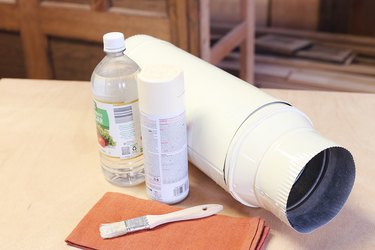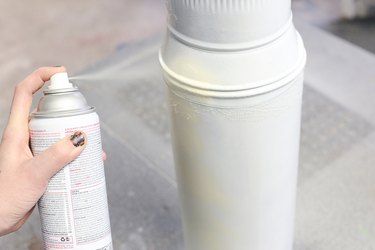Things You'll Need
Mineral spirits
Denatured alcohol
White vinegar
Acrylic latex metal primer
Paintbrush or air spraying equipment
Acrylic latex paint

Galvanizing steel by dipping it in zinc makes the metal rust-resistant. Zinc is reactive, and zinc oxidation creates a thin film of dust that you have to remove before painting, or the paint you're applying won't adhere. This necessitates a thorough cleaning of your galvanized ducts before you paint them to camouflage them or match them with the room decor. It's best to use latex paint, and because ducts are located in out-of-the-way places, you can usually get away with using a paintbrush. If the ducts are prominent, though, you may want to spray paint them.
Step 1

Moisten a rag with mineral spirits or denatured alcohol. Wipe the ducts you plan to paint with the moistened rag. Either solvent will remove any greasy or oily deposits that could interfere with paint adhesion.
Video of the Day
Step 2

Wipe the ducts a second time, this time using a rag moistened with white vinegar. Vinegar is a mild acid that etches the zinc coating and makes it more receptive to paint. Let the vinegar dry completely before you proceed.
Step 3

Prime the metal with an acrylic latex metal primer. Brush the primer with a synthetic bristle paintbrush or, if you want to avoid brush marks, spray it using aerosol cans or air spray equipment. If the ducts will get hot, use a primer with a high heat resistance. Conventional primers can withstand temperatures up to 120 degrees Fahrenheit, but you can also buy products that can withstand temperatures up to 170 degrees F.
Step 4

Allow the primer to dry for two hours or more, and then paint the ducts with acrylic latex paint. Use a product that can withstand moderately high heat if the ducts get hot. Apply the paint with a paintbrush, or spray it.
Step 5

Let the first coat of paint dry. Then apply a second coat. You shouldn't have to sand between coats.
Tip
Ducts seldom get hot enough to require a high-temperature enamel, such as you would use to paint stove pipes. In most cases, conventional flat, semigloss or high gloss acrylic latex paint will work.
Warning
If you decide to spray the paint, be sure to cover everything in the room that you don't want painted, using plastic sheeting, masking paper and masking tape. Wear protective clothing, goggles and a respirator.
Video of the Day